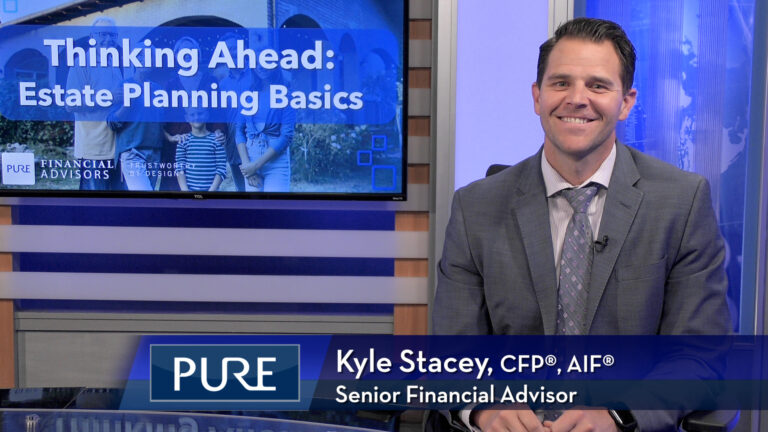Medicare Part B is a crucial part of your healthcare coverage as you enter retirement, covering the costs of essential medical services. Pure’s Senior Financial Advisor, Phillip Chinothai, CFP®, AIF®, simplifies this aspect of Medicare, helping you plan for your healthcare needs in retirement.
He discusses:
- Eligibility requirements
- Costs
- How to Use Medicare Part B
FREE GUIDE | Medicare Checkup Guide
Transcript
Medicare Part B is often referred to as medical insurance, while Part A covers inpatient hospital care, Part B is designed to help you with the costs for outpatient medical services. This includes doctor visits, preventive services, routine testing, and a small amount of medical equipment. Note that Part B does not include items such as dental care, eye exams, hearing aids, nursing home coverage or coverage while travelling abroad. If you like your existing doctors, you should confirm if they will accept Medicare as some doctors opt-out of the program.
Eligibility Requirements
You’re generally eligible for Medicare Part B once you turn age 65 or, if you’ve been receiving disability benefits for at least 24 months. You can enroll in Part B during your Initial Enrollment Period, which begins three months before, and three months after your 65th birthday month, so essentially you have a 7-month window to apply. You should also know that there is a penalty if you apply late. The penalty is an additional 10% premium for every year that you were eligible, but did not enroll. This penalty can be waived if you qualify for certain special exemptions, such as still working and having health insurance through your employer. If you are still working and you would rather use your existing health insurance coverage, you can potentially wait until you retire but it still may be worth looking into Medicare since it may be more cost effective.
Costs
Now Medicare Part B isn’t free. The premiums are standardized by the Center of Medicare Services and typically increase every year. There’s a base premium which is $174.70 per month for 2024, and then some individuals may have an even higher premium based on their income from two years prior. So, your 2024 premiums are based on your modified adjusted gross income from your 2022 tax return. This means that you should pay extra attention to tax planning because what you do today may affect your Medicare premiums two years down the road.
Using Medicare Part B
When it comes to using Medicare Part B, there is an annual deductible of $240 and then the average co-payment is 20%. Many people are also surprised to learn that there is no out-of-pocket maximum or financial cap if you only have the original Medicare Part B. Health care costs can really skyrocket if you have a significant diagnosis that requires intensive care. With that being said, you can consider purchasing a Medicare supplemental health insurance plan or look into a Medicare advantage plan to cover the gaps where the original Medicare Part B may lack.
In summary, Medicare Part B is a critical component of your healthcare coverage as you enter retirement. It helps cover the costs of medical services that are necessary to maintain your health. If you have any more questions or need further guidance, take advantage of our Free Financial Assessment and see how Medicare fits into your overall retirement plan.
Subscribe to our YouTube channel.
IMPORTANT DISCLOSURES:
• Investment Advisory and Financial Planning Services are offered through Pure Financial Advisors, LLC, a Registered Investment Advisor.
• Pure Financial Advisors LLC does not offer tax or legal advice. Consult with your tax advisor or attorney regarding specific situations.
• Opinions expressed are subject to change without notice and are not intended as investment advice or to predict future performance.
• Investing involves risk including the potential loss of principal. No investment strategy can guarantee a profit or protect against loss in periods of declining values.
• All information is believed to be from reliable sources; however, we make no representation as to its completeness or accuracy.
• Intended for educational purposes only and are not intended as individualized advice or a guarantee that you will achieve a desired result. Before implementing any strategies discussed you should consult your tax and financial advisors.
• Pure Financial Advisors, LLC, is not affiliated with any government agency, including, but not limited to Medicare.
CFP® – The CERTIFIED FINANCIAL PLANNER™ certification is by the Certified Financial Planner Board of Standards, Inc. To attain the right to use the CFP® designation, an individual must satisfactorily fulfill education, experience and ethics requirements as well as pass a comprehensive exam. Thirty hours of continuing education is required every two years to maintain the designation.
AIF® – Accredited Investment Fiduciary designation is administered by the Center for Fiduciary Studies fi360. To receive the AIF Designation, an individual must meet prerequisite criteria, complete a training program, and pass a comprehensive examination. Six hours of continuing education is required annually to maintain the designation.













